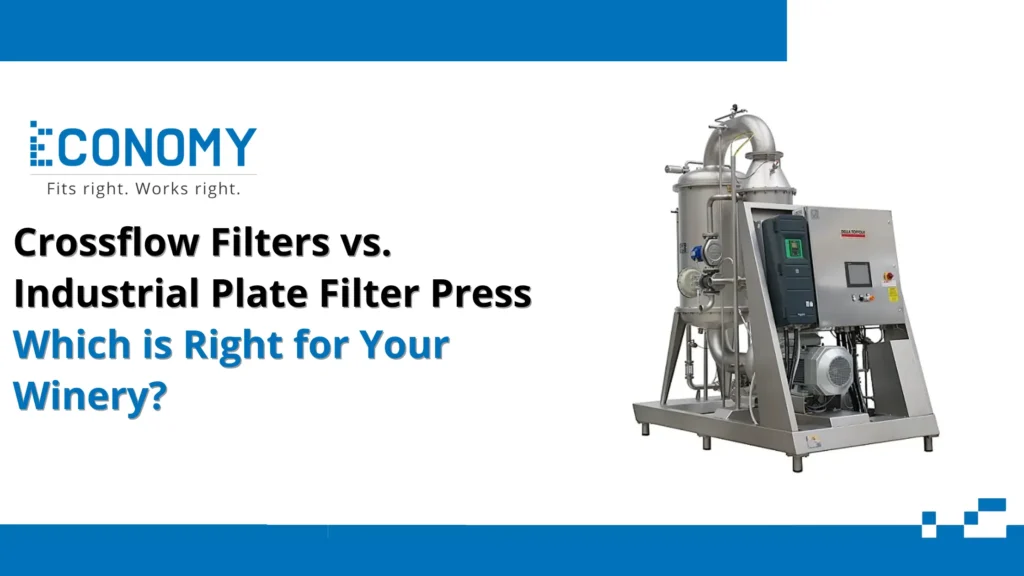
What is Crossflow Filtration and How Does It Work?
Crossflow filtration is a modern wine clarification technique that filters wine through a semi-permeable membrane. Unlike traditional filtration methods, in crossflow systems, the wine flows tangentially (across) the filter membrane rather than directly through it. This technique prevents the buildup of solids on the filter surface and maintains a consistent flow rate. It efficiently removes yeast, bacteria, and suspended solids, producing brilliantly clear wine without the need for filter aids like diatomaceous earth (DE). Crossflow filtration is fully automated, requiring minimal manual intervention, and offers a sterile, eco-friendly method for wine polishing and stabilization.
Comparing Crossflow Filters and Plate Filter Presses
Crossflow filters and industrial plate filter press are both used for wine clarification, but they differ significantly in design, operation, and performance.
Crossflow Filters:
- Use a hollow-fiber or spiral-wound membrane.
- Fully enclosed and automated.
- Suitable for all wine types, including red, white, and rosé.
- Require little to no filter aid.
- Offer sterile filtration in a single step.
- Minimal wine loss due to continuous circulation.
Plate Filter Presses:
- Consist of a series of plates covered with filter media (pads or sheets) held together in a frame.
- Use gravity or pressure to push wine through filter pads.
- Often require filter aids like DE.
- Typically used in batch operations.
- More labor-intensive and generate more waste.
- Can result in wine loss due to absorption in pads.
While plate filters are cost-effective and widely used in small to mid-sized wineries, crossflow systems are gaining popularity for their automation, efficiency, and quality output.
Disadvantages of Plate and Frame Filter Presses
Though plate and frame filter presses have served the wine industry for decades, they come with notable drawbacks:
- Labor Intensive: Operators must assemble, disassemble, clean, and replace filter pads, which is time-consuming.
- Use of Filter Aids: Often requires DE, which presents health risks during handling and disposal issues.
- Wine Loss: Pads absorb a portion of the wine, reducing yield.
- Non-Sterile Filtration: Additional filtration steps may be needed to achieve microbiological stability.
- Frequent Maintenance: Pads need frequent replacement, increasing operational downtime.
These disadvantages make plate filter presses less appealing for wineries prioritizing efficiency, cleanliness, and sustainability.
Types of Filter Presses
There are several types of plate and frame filter presses used in wineries, each suited to different needs:
- Manual Plate Filters: Operated by hand, suitable for small wineries with limited volumes.
- Hydraulic Plate Filters: Use hydraulic pressure to compress plates, offering higher throughput and consistency.
- Membrane Filter Presses: Use inflatable membranes to squeeze wine, improving filtration rates and cake dryness.
- Automatic Filter Presses: Include automation for plate shifting and cake discharge, reducing labor requirements.
Each type varies in terms of cost, capacity, and ease of use, but all share the same fundamental limitations regarding filtration aids and manual handling.
Choosing the Right Filtration Method for Your Winery
Selecting between a crossflow filter and a plate filter press depends on your winery’s production scale, budget, and quality goals. Crossflow filters are ideal for wineries seeking:
- Automation and Labor Savings: Reducing human intervention.
- High Wine Clarity and Stability: Achieving brilliant polish in one pass.
- Sterile Filtration Capabilities: Preventing spoilage microorganisms.
- Eco-Friendly Operations: Minimizing waste and chemical usage.
Plate filter presses may be more suitable for:
- Lower Capital Investment: Especially for small wineries.
- Batch Processing Preferences: With more control over each cycle.
- Traditional Filtration Workflows: Where staff is already trained in DE handling and pad replacement.
Factors to Consider in Your Decision
When deciding on a filtration system, evaluate the following factors:
- Production Volume: Larger volumes benefit from the continuous, automated nature of crossflow systems.
- Labor Availability: Crossflow reduces manual workload and operator fatigue.
- Wine Style and Stability Requirements: Delicate wines prone to microbial spoilage require sterile filtration.
- Sustainability Goals: Crossflow systems align better with eco-conscious practices.
- Operational Budget: While crossflow systems are more expensive initially, they offer long-term savings in labor and consumables.
- Available Space: Plate presses require more physical space for setup and operation.
Each winery’s needs are unique, and the ideal system balances efficiency, cost, and wine quality.
Wine Type and Filtration Requirements
Different wine types have specific filtration needs:
- White Wines: Often require higher levels of clarity and microbiological stability, favoring crossflow filtration.
- Red Wines: Can tolerate slightly more turbidity; both systems can be used effectively.
- Sparkling Wines: Require sterile filtration to avoid refermentation in the bottle, making crossflow filtration more suitable.
- Natural or Organic Wines: May benefit from minimal processing, though crossflow can be adjusted for gentler treatment.
Understanding your wine style and desired outcome is key to choosing the right filtration technology.
Making the Best Choice for Your Winery
In conclusion, crossflow filters offer significant advantages in automation, hygiene, efficiency, and quality output, making them ideal for modern wineries aiming for premium wines with minimal loss. However, for traditional, small-scale, or budget-conscious producers, plate filter presses still hold value due to their affordability and straightforward design.
Ultimately, the best choice depends on your winery’s goals, budget, wine styles, and long-term vision. Investing in the right filtration system enhances wine quality, streamlines operations, and helps position your winery for success in an increasingly competitive industry.




